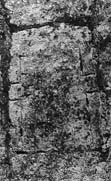Select a site alphabetically from the choices shown in the box below. Alternatively, browse sculptural examples using the Forward/Back buttons.
Chapters for this volume, along with copies of original in-text images, are available here.
Object type: Grave-marker or -cover
Measurements: L. 54 cm (21.3 in) W. 40 > 34 cm (15.7 > 13.4 in) D. Built in
Stone type: [Ancaster Freestone, Upper Lincolnshire Limestone, Inferior Oolite Group]
Plate numbers in printed volume: Ill. 321
Corpus volume reference: Vol 5 p. 241
(There may be more views or larger images available for this item. Click on the thumbnail image to view.)
This appears to be either a large rectangular grave-marker or -cover with incised decoration on the only visible face.
A (broad): Any original border decoration has been lost. The surviving part of the stone is decorated with a pair of rectangular outline crosses (type A1) placed side-by-side, which are clearly visible, even if badly abraded. The crosses are formed by precisely cut incised lines of U section. Although the central part of the design is worn right away, it seems likely that the two cross-arms touched or joined at this point.
If this stone is viewed as a grave-marker it should belong to the group of large rectangular stones such as Lincoln St Mark 16, 17, etc. (Ills. 256, 259). Like other examples in this group, Ropsley also employs a type A1 cross-head, but no others have the unusual motif of paired crosses. If Ropsley 1 were a marker of this type, then a border moulding has probably been removed during reuse. The Ropsley stone could, however, also have come from a large cover similar to Lincoln St Mark 9, 10, etc. (Ills. 245, 246–7), but if so it has lost much of its length, and the crosses would seem to be placed a long way up the stone. There are, however, no early examples of covers with paired crosses of this type, and of the two options – cover or marker – the latter is probably preferable. Viewing Ropsley 1 as a marker allows comparison with those examples of markers with several crosses discussed by Trollope (1853). Of this group only that at North Rauceby (no. 3) has some similarities with Ropsley. Like Ropsley, North Rauceby 3 also has a pair of type A1 crosses although they are treated quite differently (Ills. 420–3). The cross type, together with the size and proportions of the monument represented, probably suggest a date in the late tenth or eleventh century, and the fact that it was reused in a twelfth-century fabric probably also suggests a terminus ante quem, although it is also possible that the stone represents a later repair.



